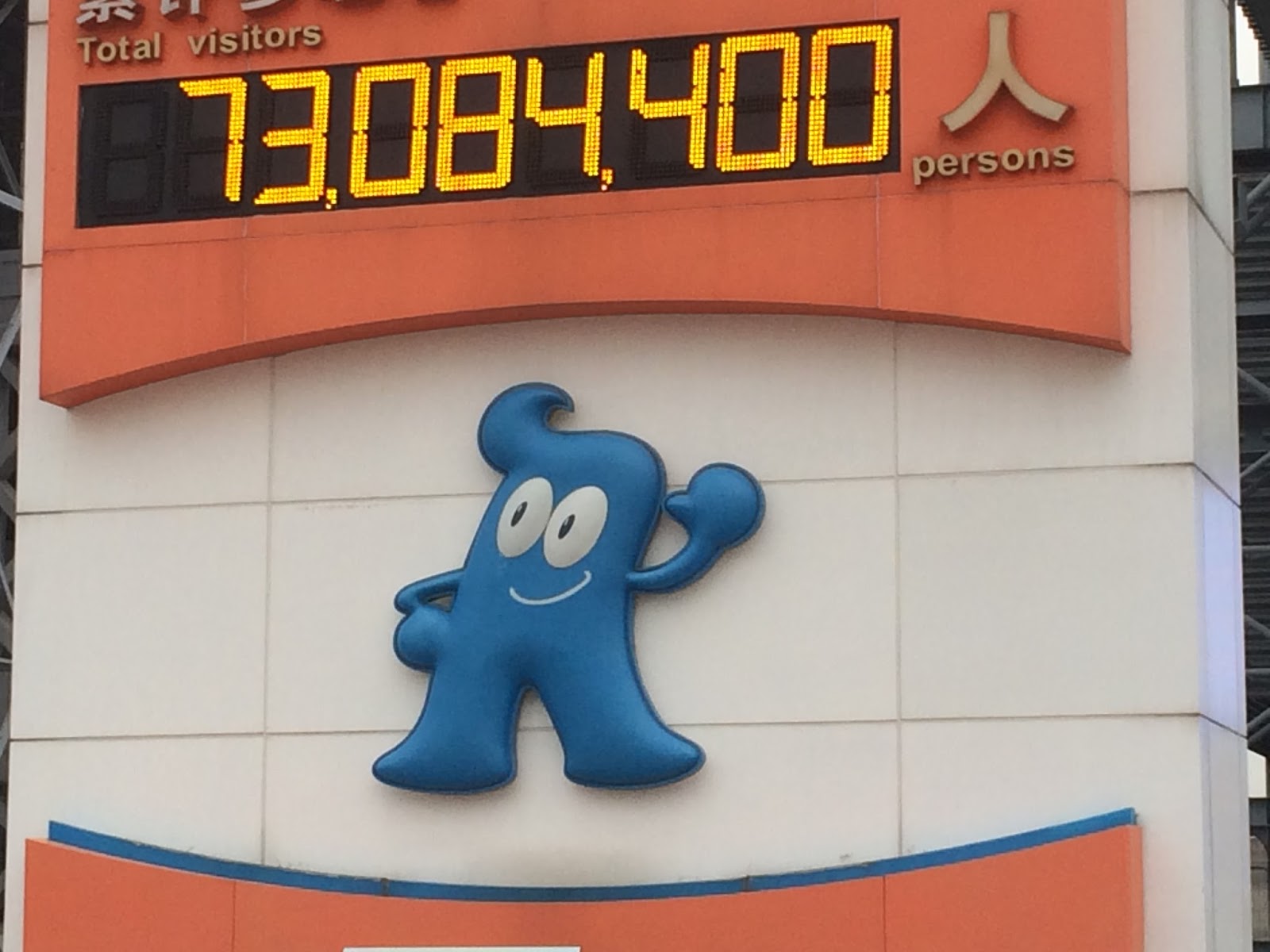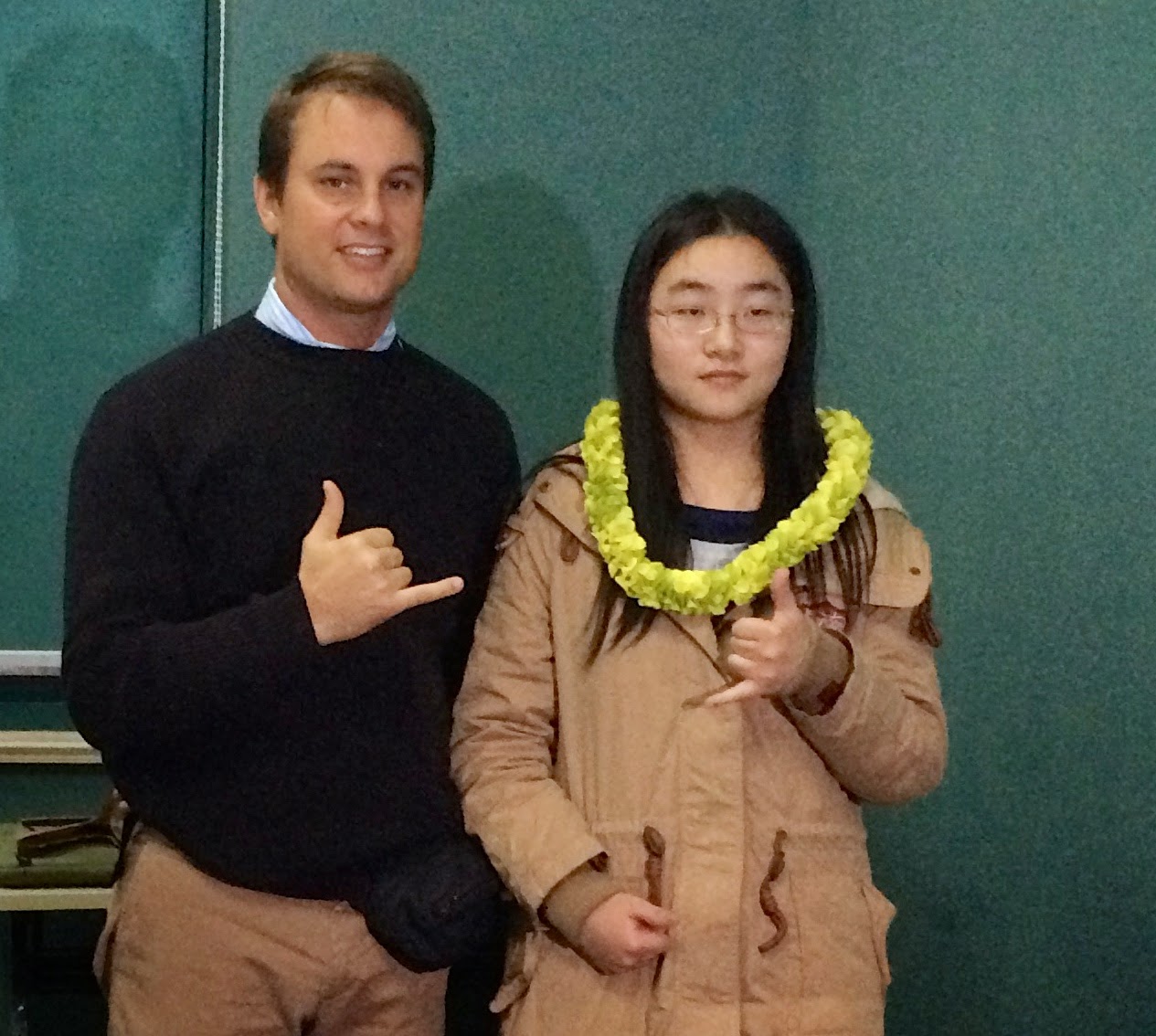Journey Into China: Day 6: A Party for 75 million, the World's Biggest Baby, & Student Searching in Songjiang
 |
| The World's Biggest Baby: Read On to Find Out. . . |
Today we have a full afternoon program, but the morning is mine.
I arise first thing, devour the breakfast buffet, and scurry underground into the metro. I’m becoming more familiar with deciphering the metro map, navigating Chinese crowds, and moving seamlessly through new stations. I take the metro straight south through Old Shanghai to the banks of the Huangpu River.
I pop above ground in a place I’ve never been before, and using my cardinal directions, I walk south and west. This part of town is new and under construction, as riverside high rises soar into the sky in this appealing section of the city.
The streets are packed and empty at turns, a strange phenomenon of Chinese cities where the infrastructure has run out ahead of private car ownership in some cases so far.
 |
| That's a lot of visitors. . . |
I encounter a series of colossal square buildings by the river, and I find the somewhat hidden entrance to the Shanghai Expo Memorial Exhibition.
 |
| Nationalism is a force in China. |
The Shanghai Expo was a six month long world culture celebration that the Chinese hosted in 2010. Imagine the Chicago World’s Fair at the turn of the 20th century; now update that vision to 21st century China. Of course the hosts went completely over the top, using the Expo as a coming out party for Shanghai, right on the heels of the 2008 Beijing Olympics, to celebrate 30 years of relentless economic growth. Every country on Earth was invited to contribute exhibitions, performances, art, architecture, and more. Most countries accepted the invitation.
 |
| "Overall human development is a prerequisite for sustainable development of cities." An elegant truth. |
In preparation for the project, Chinese officials cleared out a mile long section on both sides of the Huangpu River. Residents were relocated, buildings were razed, and a collection of buildings were erected over an eight year period that included Mercedes-Benz Arena, the Chinese Art Museum, boardwalks and boulevards, tens of exhibition buildings, and hundreds of other structures.
Over a period of 180 days 75 million people visited the Expo to experience, eat, enjoy, learn, walk, participate, and commune. From what I can see, it was one of the most spectacular world celebrations in history.
And then it was over. The doors closed. The major venues continued on as key resources for Shanghai culture, but much of the Expo grounds are now a decaying ghost city, a setting for some apocalyptic Stephen-King alternate reality where the buildings are there but the people are gone. It’s eerie, and not unlike a hundred other places in China that have been built only for nobody to come. The authorities ran the event 19 billion yuan into the red, or some U.S. $3 billion dollars into debt. You can get away with that kind of grandiosity and mis-management when you’re the only Party in town.
 |
| My American students would challenge this. . . |
I enter the the soaring three story warehouse that houses the memorial exhibition. I pass by armies of tiny children in uniform moving in formation, taking pictures, flashing peace signs, and all yelling “Yeahh!!!!” in unison.
The first floor shows all of the logistics and infrastructure that went into the event. Construction, planning, legal consultation, publicity, security, amenities, food and beverage: the scale of the event was much like China: unfathomably colossal.
The second floor begins with a 200 foot long curving screen that covers two walls; it’s the most impressive screen I’ve ever seen. It begins by showing an animated depiction of old Shanghai in Martin Hanford’s “Where’s Waldo” style, with hundreds of animated Chinese people moving around an idealized medieval Shanghai, all around the Huangpu River. Then, as the music changes to angelic voices singing a kind of Chinese “It’s A Small World,” the city transforms into an animated aerial view of the 2010 Expo grounds, with thousands of little animated people thronging through the buildings and exhibits, on the roads and across the river, while blimps, planes, boats, and buses all move along. I’m enraptured.
The rest of the second floor is dedicated to each province in China, accompanied by artistic treasures, maps, and descriptions of these provinces. There are over 30 provinces, and even though I’ve studied China, every region feels like an unknown, magical, and enticing land. I hope I can see all of these places before my time is up.
The top floor is an exhibit of all of the countries and organizations that participated in the Expo; it’s a sort of greatest hits of the Expo, with photographs, artistic masterpieces, and key insights or ideas from each place or organization. As well as countries and cities, exhibits are present from the United Nations, China Petroleum, United Aviation, and a host of other world-shaking bodies.
This Expo is one of the best experiences I’ve had in Shanghai; I recommend it to everyone.
I taxi back to the hotel and I succumb to my craving for some familiar Western food by eating a Chicken sandwich at McDonald’s. The French Fries are far less salty here.
After lunch we meet in the lobby and file into our taxi to drive west out to Songjiang, a satellite city, to visit International Studies University. The hourlong drive carries us through the ceaseless urban agglomeration of Shanghai. It simply never ends, and neither do the cranes that continue to extend the city’s tentacles.
 A muted grey sky and a brusque chilly wind greet us at the University. The campus is constructed in a variety of classical European styles, though the buildings likely went up in the last twenty years. The primary campus building looks like a European capital building, with a gargantuan dome topping an imposing ten story edifice fronted by gardens of Versailles-like dimensions.
A muted grey sky and a brusque chilly wind greet us at the University. The campus is constructed in a variety of classical European styles, though the buildings likely went up in the last twenty years. The primary campus building looks like a European capital building, with a gargantuan dome topping an imposing ten story edifice fronted by gardens of Versailles-like dimensions. We file into a boardroom, and then into a classroom, where Steven Hong presents our five schools to a room full of 40 Chinese students. These are early high school students who come to the Affiliated High School of International Studies University, and then fan out to schools around the world, especially in America, if they can. All seven of our American schools present aim to persuade some of them to come to our schools.
We file into a boardroom, and then into a classroom, where Steven Hong presents our five schools to a room full of 40 Chinese students. These are early high school students who come to the Affiliated High School of International Studies University, and then fan out to schools around the world, especially in America, if they can. All seven of our American schools present aim to persuade some of them to come to our schools.  I spend the next two hours interviewing ten Chinese students in a private room with a Chinese teacher present to help me. My questions fall into a pattern: How old are you? What grade are you in? Have you traveled abroad? What do you know about Hawai’i? What do you know about America? How do you feel about studying in America? Are you excited? Are you nervous? What do you like to do? What do you like to study?
I spend the next two hours interviewing ten Chinese students in a private room with a Chinese teacher present to help me. My questions fall into a pattern: How old are you? What grade are you in? Have you traveled abroad? What do you know about Hawai’i? What do you know about America? How do you feel about studying in America? Are you excited? Are you nervous? What do you like to do? What do you like to study?
The students seem curious, excited, and interested, but it is hard to tell who is curious to talk to me and who is motivated to study in Maui. Only time will tell.
 It’s a productive session. We file out into the chilly evening darkness, take pictures with students and teachers, bid adieu, and return to our taxi bus for the rush hour commute back into Shanghai. The ride back into central Shanghai is a circus of traffic, LED lights, and illuminated high-rises.
It’s a productive session. We file out into the chilly evening darkness, take pictures with students and teachers, bid adieu, and return to our taxi bus for the rush hour commute back into Shanghai. The ride back into central Shanghai is a circus of traffic, LED lights, and illuminated high-rises. We disembark in Xintiandi, a fashionable district of restaurants, shops, museums, and pubs. It’s a low rise area of three story buildings reconstructed in traditional style with snake alleys and secret alcoves; it’s pricey, exclusive, international, and peppered with the world’s luxury goods brands. After last night’s Hot Pot adventure, Steven has brought us here for more familiar German food (bratwurst, pretzels, lager). It turns out to be our most expensive and least delicious meal, but the atmosphere is warm and festive, with live jazz singers, decorated Christmas trees, interior wood paneling, and a welcome reprieve from the cold outside.
We disembark in Xintiandi, a fashionable district of restaurants, shops, museums, and pubs. It’s a low rise area of three story buildings reconstructed in traditional style with snake alleys and secret alcoves; it’s pricey, exclusive, international, and peppered with the world’s luxury goods brands. After last night’s Hot Pot adventure, Steven has brought us here for more familiar German food (bratwurst, pretzels, lager). It turns out to be our most expensive and least delicious meal, but the atmosphere is warm and festive, with live jazz singers, decorated Christmas trees, interior wood paneling, and a welcome reprieve from the cold outside.
The day is done. I bid goodbye to Steven Hong, a key figure in the Educatius Shanghai office who has taken immaculate care of me during my week in China. I shall miss him.
I stroll briefly after dinner, then take refuge in the private, warm, quiet comfort of my hotel room.

Comments
Post a Comment